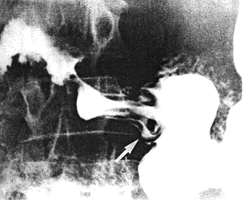



Go to chapter: 1 | 2 | 3 | 4 | 5 | 6 | 7 | 8 | 9 | 10 | 11 | 12 | 13 | 14 | 15 | 16 | 17 | 18 | 19 | 20 | 21 | 22 | 23 | 24 | 25 | 26 | 27 | 28 | 29 | 30 | 31 | 32 | 33 | 34 | 35 | 36 | 37 | 38 | 39
Chapter 36 (page 180)
Chapter 36
Sessile Polyps in the Sphincteric Cylinder
A number of gastric lesions may present as polyps; however, the term polyp is usually
used to indicate a benign epithelial tumor (Marshak and Lindner l97l).
In 2420 double-contrast radiographic studies of the stomach Gordon et al (l980)
encountered polyps in 38 (1.6 %). Most were of an inflammatory or hyperplastic
nature; none was associated with gastric malignancy. Solitary polyps tended to occur in
the "antrum", while multiple polyps (usually 2 or 3) were more often located in the
gastric fornix and body. Two-thirds were less than 1.0cm in diameter, only one being
larger than 2.0cm; most were sessile and could not be removed by a snare. The
surrounding mucosa was either normal or showed evidence of acute or chronic gastritis.
However, Laxen et al (l983), in a study of 183 patients with gastric polyps, found
epithelial dysplasia and increased prevalence of intestinal metaplasia in most.
The following case shows interesting features:
Case Report
Case 36.1. W.V.W., 46 year old male, presented with vague upper abdominal
symptoms. Cholecystectomy had been done 3 years previously. Radiographic
examination showed a round, polyp-like lesion 1.5cm in diameter and surrounded by a
circular mucosal fold, in the centre of the pyloric sphincteric cylinder (Fig 36.1A).
Cyclical contractions of the cylinder were normal; during contraction the polyp moved in
an orad direction, and with maximal contraction it was located approximately 2.0cm
more orally (Fig 36.1B). Gastroscopy confirmed the presence of a benign, sessile polyp;
histologically the mucosa was normal. At gastrostomy the polyp could not be located.
Follow-up radiography and gastroscopy 3 years later showed it to be unchanged.
A | |
B | Fig. 36.1 A,B.
Case W.V.W. A Round, sessile, benign polyp (arrowed) in centre of pyloric
sphincteric cylinder.
B Near maximal contraction of sphincteric cylinder. The polyp
(arrowed) has moved in an orad direction
|
In a case of Peutz-Jeghers syndrome, a pair of sessile mucosal polyps in the pyloric
sphincteric cylinder also moved in an orad direction during contraction of the cylinder.
Previous Page | Table of Contents | Next Page
© Copyright PLiG 1998








